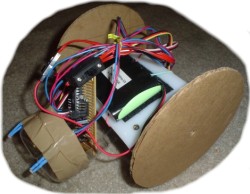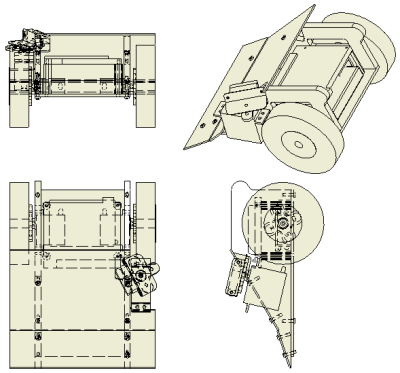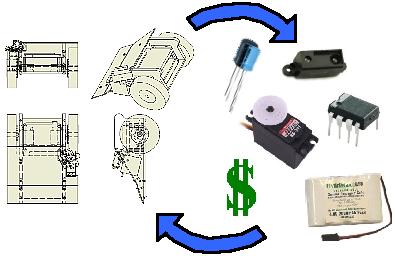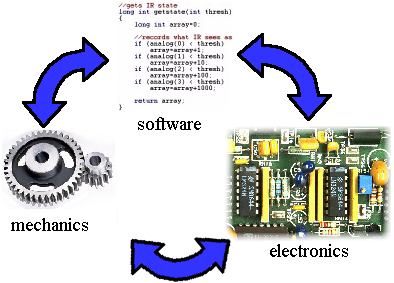- a chance/opportunity
- outside guidance
- wires
- screws
- four 1.5V batteries (rechargeable NiMH are best)
- cardboard
- waterbottle
- two rubber bands
- chopsticks/popsicle sticks
- scotch/duct tape
- serial port on your computer
- if no serial port, get a usb to serial adaptor cable
- sharp scissors
- soldering iron
- solder roll (22 to 25 gauge)
- multimeter (not required, but good to have)
- safety goggles (you only have two eyes)

 Then in my sophomore year in college, I took my first robotics class. The professor gave us an optional project to build our own robot, and offered money to anyone up to the challenge. It was my chance! Still had no idea what I was doing, but I had money to do it! I immediately started drawing up plans, and began talking with people. Still clueless, I spoke to two mechanics, a biochemist, a CS prof. Combined I knew enough to go to Home Depot and buy a bunch of steel beams that I knew somehow magically connected together. Soon after, I remember walking into theCMU Robotics Club and saying 'I have these steel beams and I want to cut them to size, how do I do it?' At first confused by my high level of incompetence, they agreed to show me how to use the bandsaw. From that point on, if I needed help, I knew where to find it. Ok so my first robot was a complete failure, but its where I learned all the basics to get me started on my own . . . and the rest is history . . . The point of that story is that people need just two things to build a robot:
Then in my sophomore year in college, I took my first robotics class. The professor gave us an optional project to build our own robot, and offered money to anyone up to the challenge. It was my chance! Still had no idea what I was doing, but I had money to do it! I immediately started drawing up plans, and began talking with people. Still clueless, I spoke to two mechanics, a biochemist, a CS prof. Combined I knew enough to go to Home Depot and buy a bunch of steel beams that I knew somehow magically connected together. Soon after, I remember walking into theCMU Robotics Club and saying 'I have these steel beams and I want to cut them to size, how do I do it?' At first confused by my high level of incompetence, they agreed to show me how to use the bandsaw. From that point on, if I needed help, I knew where to find it. Ok so my first robot was a complete failure, but its where I learned all the basics to get me started on my own . . . and the rest is history . . . The point of that story is that people need just two things to build a robot:  If you are a serious builder, build/buy your robot parts under the assumption they will be scraped for robots in the future. Beginners often spend between $100-$400 for their first 2 or 3 robots, while experts spend about $0-$40 for their robots. Why is this? Its because they made the long-term investment. If you are going to build robots the rest of your life, spend for the long term. The investment will pay for itself. In all honesty, you may end up spending $150+ for this robot, but if you are willing to make the investment, in the long term it will pay off. Either way, I will give multiple options throughout the tutorial to match each persons wallet (or lack of). Speaking of which, are you just too poor to invest? If you want to know more about paying for robots, read my robot funding tutorial. And just so you know, I designed this robot in such a way that people who arent serious wont waste money, and those who are serious get good parts to scrap for their next robot. A quality robot, for under $50. =P Beginning the Tutorial - Design and Part Selection As I mentioned, I will teach you the process of making a robot, as you make it. The very first step anyone would make would be to design your robot. Interestingly this is where beginners fail. Beginners spend 90% of their time building, and 10% designing. Experts are the opposite - 90% designing and 10% building. Of course when you are a beginner its hard to design - you dont always know what works until you try it. But planning never hurts. A good example of planning a robot would be the CAD work I did for my sumo robot, Stampy:
If you are a serious builder, build/buy your robot parts under the assumption they will be scraped for robots in the future. Beginners often spend between $100-$400 for their first 2 or 3 robots, while experts spend about $0-$40 for their robots. Why is this? Its because they made the long-term investment. If you are going to build robots the rest of your life, spend for the long term. The investment will pay for itself. In all honesty, you may end up spending $150+ for this robot, but if you are willing to make the investment, in the long term it will pay off. Either way, I will give multiple options throughout the tutorial to match each persons wallet (or lack of). Speaking of which, are you just too poor to invest? If you want to know more about paying for robots, read my robot funding tutorial. And just so you know, I designed this robot in such a way that people who arent serious wont waste money, and those who are serious get good parts to scrap for their next robot. A quality robot, for under $50. =P Beginning the Tutorial - Design and Part Selection As I mentioned, I will teach you the process of making a robot, as you make it. The very first step anyone would make would be to design your robot. Interestingly this is where beginners fail. Beginners spend 90% of their time building, and 10% designing. Experts are the opposite - 90% designing and 10% building. Of course when you are a beginner its hard to design - you dont always know what works until you try it. But planning never hurts. A good example of planning a robot would be the CAD work I did for my sumo robot, Stampy:  Typically the design phase is an iterative process/cycle between design and part selection, meaning the designer juggles between the design he would like, and the affordable parts available on the market. The designer will keep redesigning until both reach a harmony - often a long and tedious task. There have been several times where I spent a week designing a circuit, only to find out a key chip I need has been sold out and no longer exists! It forces me to redesign the whole darn thing. Pain!
Typically the design phase is an iterative process/cycle between design and part selection, meaning the designer juggles between the design he would like, and the affordable parts available on the market. The designer will keep redesigning until both reach a harmony - often a long and tedious task. There have been several times where I spent a week designing a circuit, only to find out a key chip I need has been sold out and no longer exists! It forces me to redesign the whole darn thing. Pain!  But lucky for you, I designed this robot using highly available, easily replaceable components. For this tutorial you can mostly skip the design/part selection phase, but its still a very important skill you will need to learn. In the future, if you are looking for robot components, I have written up a robots parts list to save you time. Parts List Starting you off, these are the parts you need to purchase. Buy them right after you read through this tutorial, but before you start building anything. That way the parts have time to ship while you are building the robot chassis. Note that some of the parts in the optional list can replace the more expensive parts in the required list. Required Parts:
But lucky for you, I designed this robot using highly available, easily replaceable components. For this tutorial you can mostly skip the design/part selection phase, but its still a very important skill you will need to learn. In the future, if you are looking for robot components, I have written up a robots parts list to save you time. Parts List Starting you off, these are the parts you need to purchase. Buy them right after you read through this tutorial, but before you start building anything. That way the parts have time to ship while you are building the robot chassis. Note that some of the parts in the optional list can replace the more expensive parts in the required list. Required Parts: | Item | Cost each ($) | Quantity | Website, Part # |
| Hitec HS-311 servo (modify the servo) | 8.99 | 2 | Servocity.com 31311S |
| 5V Linear Regulator | .50 | 1 | DigiKey.com KA7805ETU-ND |
| ATmega8 AVR | 3.66 | 1 | DigiKey.com ATMEGA8-16PU-ND |
| 28 pin DIP socket | 1.68 | 1 | DigiKey.com ED3128-ND |
| 220uF+ Electrolytic Capacitor | .32 | 1 | DigiKey.com 565-1038-ND |
| .1uF Ceramic Capacitor | .13 | 1 | DigiKey.com 399-4454-1-ND |
| 36 position breakaway male header | 1.74 | 2 | DigiKey.com WM6436-ND |
| 340ohm resistor | .95 | 5 pack | DigiKey.com PPC340YCT-ND |
| 1.62Kohm resistor | .49 | 5 pack | DigiKey.com 1.62KXBK-ND |
| LED | .19 | 1 | DigiKey.com 160-1034-ND |
| CdS Photoresistors | 2.99 | 5 pack | RadioShack 276-1657 |
| Grid-Style PC Board with 371 Holes | 1.99 | 1 | RadioShack 276-149 |
| Enclosed 4 AA Battery Holder (with On/Off switch) | 1.99 | 1 | RadioShack 270-409 |
| 9V Battery | .25 | 1 | any store |
| 6v 1400mAh NiMH Battery | 11.95 | 1 | |
| AVR STK Serial Port Dongle Programmer | 12.95 | 1 | AVR-PG1 |
| AVR ISP2 Programmer | 34 | ATAVRISP2-ND | |
| Pocket AVR Programmer | 15 | 1 | PGM-09231 |


0 comments:
Post a Comment